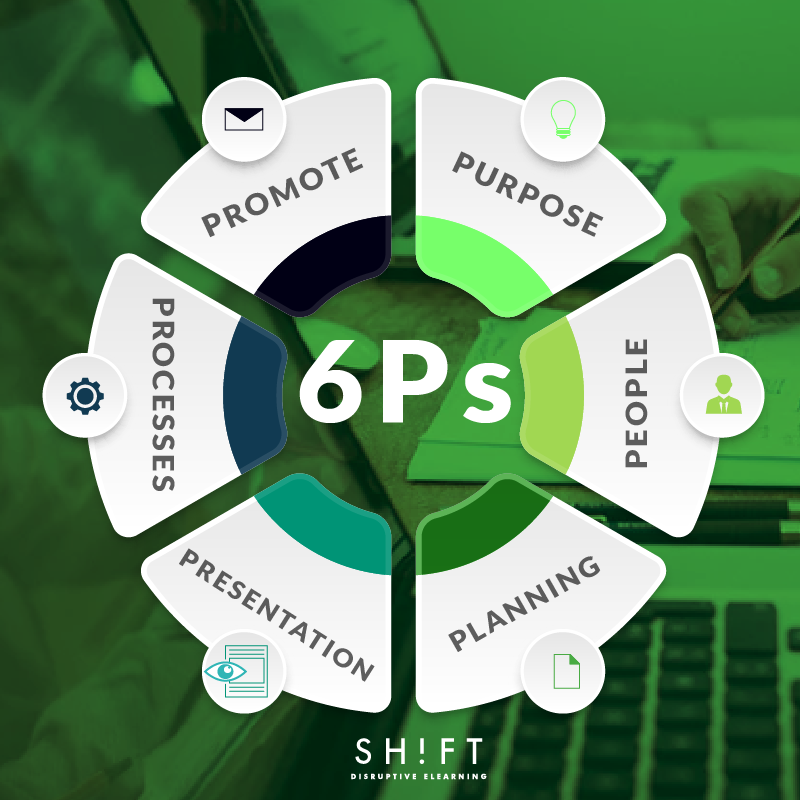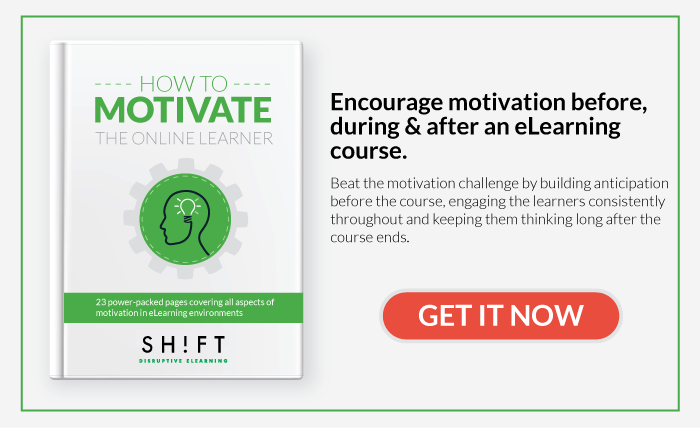Have you ever taken an eLearning course and found it to be less than what you expected when you had it completed? You were hoping to learn more, or even felt your precious time consumed without benefit to your mind?
At one point in time or another, we all have! However, your learners can be the exceptions to this rule! By maintaining the 6-Ps of eLearning, your audience will never waste their precious time! And they will continue to enjoy and come back to your courses – from the first course to the hundredth!
Let’s start by mentioning what these 6 - Ps are:

Let’s start by mentioning what these 6 - Ps are:
- PURPOSE – Your defined purpose of the eLearning course.
- PEOPLE – Your defined eLearning audience.
- PLANNING – Your defined eLearning goals.
- PRESENTATION – Your defined design plan for visual design
- PROCESSES – Your defined plan to train and deliver the material
- PROMOTION – Your defined plan to get your eLearning course “out there.”
It makes sense when you see the 6 -P's together, to note that each works closely with the others. Also, it is easy to note that as they each are interdependent upon the others if one of these elements were to be overlooked or missed, the design of your eLearning course might not prove fruitful.
1) Purpose: What is the Purpose of Your eLearning Course?
Even before start designing your eLearning course, it is essential to have the reason for the online course wholly defined. The more in-depth you can describe your project, the better your project will become.
Some of the best ways to determine the purpose of your eLearning course are to insert yourself into the different roles of the parties looking to gain value from your project.
By putting yourself into the role of the employer, you can define the materials of the course. Employers seek to have eLearning courses designed for several reasons:
- To set the corporate standards or expectations of knowledge in specific areas of the corporate business model, standards of practice, motives for safety; or many more of hundreds of defined parameters; or
- To comply with government rules and regulations; or
- To offer a broad knowledge base for employees, and by doing so, instill a sense of care on behalf of the company toward the employee.
To be sure, there are many more reasons for employers to contract eLearning course designs.
Next, you should consider inserting yourself into the role of the audience. As an audience participant, what would your expectations be? With this in mind, you will be better able to control the narrative, when you resume your role as the designer of the project.
Perhaps, as the designer, you already have your PURPOSE defined. By adding the other perspectives, your course design will take on your right tone and direction.
It is important to state that without the proper PURPOSE, even with the best eLearning authoring tool, the goal of the eLearning course will fall short. Acknowledging the PURPOSE and following it adds value to your eLearning course, that without it, your session might not resonate with your audience and might not make the impact on your company, for which it was intended.
2) People: What and Who is My Target Audience for This eLearning Course?
When thinking of your target audience, you need to answer three primary questions:
- What IS my target audience? To find what is your target audience; look closely at the current customer base, analyze the content of your course and check out the current competition content for similar courses.
- Who IS my target audience? To find who is your target audience; look closely at the corporate structure and identify the individuals who will need this course. Consider their age, their current job within the corporation and their demographics.
- Why does my target audience need this eLearning opportunity? What corporate purpose does this course fill?
By merely answering these first two questions, you can define the “persona” of the participating audience. By answering the third question, you will be able to design the needs and expectations of your future user groups.
The creation of your learner “personas” should be a realistic representation of real-to-life people and groups, with all their various social and economic backgrounds, their learning habits, their goals and both their personal & professional values.
Read more: These 27 Questions Will Help You (Really) Know Your Learners
3) Planning: What Are My Goals and Design Plans for This eLearning Course?
When designing the eLearning course, a strategic plan should provide answers to questions relating to the following:
- What are the necessary elements to certify that both the training goals and the individual development are in line with the expectations of the corporate goals and objectives?
- Who, from the company, will participate in this eLearning opportunity? Identify the team members who will take part in this training and identify their respective job functions.
- What is the subject matter? Also determine the type of learning required, concerning knowledge, skills, and behaviors.
- How many members will the training encompass? Consider the education and job level of the audience.
- Are there flexibility options built into the design of the learning initiative, which would assist or address any learning challenges uncovered during the presentation of the learning material?
- From the perspective of the corporation/organization/company: What are the expectations with regards to the benefits and results of the training for the employees attending/participating in the exercise?
- How will the training be delivered to the audience? Define the teaching methods, the learning methods, (participant’s receiving methods). Define the length of time and pace of the proposed training. Define the delivery location of the training delivery including the technique of access to the students and internet resources.
- Define the way in which the success or failure of the training is measured. Consider the depth of understanding by the audience. Decide if the audience will be asked to submit assessments, either formally (written) or informally (verbally), which outline the techniques used in the instruction, the content, and support materials; to gauge the effect on the participants.
- Recognize the resources required to implement the planned training program. Consider the delivery staff, the services, the hardware &/or software and consider the budget needed to deliver the training initiative.
- Identify possible inhibitors which could affect the positive outcome and overall success of the training initiative.
Read more: Proactive eLearning Design: 10 Essential Questions You Should Ask Before Starting
Also recommended: A List of Questions to Help You Draft a Winning eLearning Strategy
4) Presentation: What Are My Graphic Design Goals for the Course?
A professional Graphic Designer is not always necessary to achieve a pleasing and efficient eLearning experience for your learners. As the person assigned to create the eLearning course, you should be able to recognize the basic design needs for this course. For instance, the corporate identity requires matching concerning color, shapes, and fonts, along with the use of corporate logos, company names and titles.
The “goal” of good graphic design is to provide an overall positive, visually stimulating and easy-to-process “look and feel” . By establishing this positive experience for your learners, the session’s success is almost guaranteed.
Through mentally pleasing font and color choices (among other key elements, such as backgrounds, use of shapes, use of external media – visual aids, audio/video, etc.) along with the way the presentation of the information in a clear and concise language - the flow of the material to be covered will aid in the absorption of the material by the audience.
Read all about achieving effective visual design in these articles:
Understand These 10 Principles of Good Design Before You Start Your Next eLearning Project
Free: A Crash Course in Visual Design for eLearning
5) Processes: What is the "Method to Your Madness", Concerning Training Style and Delivery?
What you present in your eLearning course is important, however, how you present it is equally critical to the success of the initiative. It is necessary to implement a “method to the madness” or an “order to the chaos” of learning. As a designer, you should never let your processes be accidental or haphazard.
To handle the demands of the design process, here are a couple of golden tidbits to ease the complication of the eLearning instructional design process, for both you and your design team.
Golden Tidbit 1: The Step-by-Step Guide to Conducting a Content Inventory for eLearning
Prior to beginning the creation of any new eLearning course, your design and creation team should work up an inventory assessment of all current resources and content. Completing this assessment “religiously” will assist your efforts of course creation workflow more unassuming.
Compiling a resource material and content assessment provides real-time accounting, both of what you already have and what you can reuse. Additionally, it will give you the insight into the content yet to be created.
Golden Tidbit 2: Free Storyboard Template
The graphic design aspect of the project is favoured by eLearning designers, as are the exciting multimedia options and slide decks. Surprisingly, it is very common oversight to verify that the external elements such as charts, video, audio, YouTube links or website links, or any other type of secondary media will deploy when necessary throughout the course.
It is for this reason that great course designers intermingle the required content of the course with the secondary media and consistently test the performance of the course as the content in real-time through the creation process.
Great course designers ALWAYS create a storyboard first – to act as a roadmap and to assist in the placement of the information and the secondary media, which in turn, creates the desired flow of the curriculum.
6) Promotion: What is Your "Get-It-Out-There" Plan?
Your eLearning course is complete! All your fantastic design work and content work is about to pay off… Or is it?
Many companies realize the importance of employee continued education. Many of those same companies also recognize that the re-launch of previous online course materials and new course materials requires a plan to “market” the eLearning materials to both potential consumers and employees. The marketing plan covers incentives for employees to consume the course and also includes identifying rewards offered by the company for the consumption of the course content.
Your marketing plan should also manage the expectations of the course performance, including expectations which might be too high, too low or just ill-informed for any reason. Your marketing plan should be clear and concise and make your audience aware of the courses available to them because you are competing with untold other forces for their time and attention.
Your marketing plan is the only means of transportation you have of taking your online learning course out of the garage and onto the highway to your learners. For this reason, your plan must you appeal to your target market on EVERY level.
Read more: Want Your eLearning Courses to Deliver Results? Avoid These Mistakes
Recommended: Marketing Tips to Market Your eLearning Program Internally
When you keep the 6-Ps of eLearning, as an interlocking and interactive collaboration, the eLearning course develops into a progressive program, whereby the corporate message is relayed to the learners in a cohesive and open language, and the learners become more than just an audience for a corporate message. Your learners become the message for the corporation, by actively using the information gained in your eLearning course! And this is the successful path for both the course and the designer, which benefits the corporate body and the students of the course, alike!


